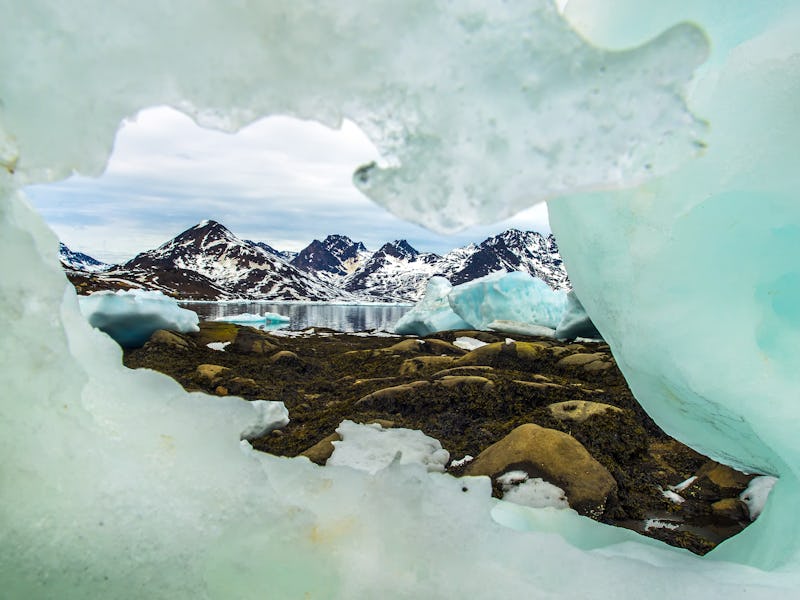A solution to pollution is actually a problem, “forever chemicals” study reveals
A potential solution is exacerbating our plastics problem instead.

When we release substances that don't biodegrade into the environment they are, eventually, bound to end up even in the most remote parts of the Earth. Take plastic, which has been detected from ocean depths to the heights of the Himalayas.
Another pervasive group of manufactured pollutants, called per- and polyfluoroalkyl substances, or PFAS, are making the similar rounds.
In a new study, researchers identify 29 types of PFAS in the Arctic Ocean. The chemicals include a newer material, called HFPO-DA. It was created to replace old compounds (PFOA and PFOS) determined to cause cancer and other health problems. Subsequently, this material has been shown to cause health problems of its own.
PFAS are known as "forever chemicals" because it can take thousands of years for them to degrade. The substances stem from a variety of sources: household goods like food packaging and cookware, as well as industrial materials in manufacturing plants, airports, and military installations.
They are also, seemingly, everywhere: in the soil, air, water; our blood. The research, published on Wednesday in the journal Environmental Science & Technology, is the first evidence that the newer PFAS have even reached the Arctic.
To track the long-lasting chemicals, the study team collected water samples from Fram Strait, the connection point between the Atlantic and Arctic Oceans. It runs between Greenland and the Norwegian archipelago Svalbard.
Higher levels of PFAS in the water were reported exiting the Arctic Ocean than entering the polar sea, indicating that the compounds are coming from the atmosphere, not the ocean itself. Snow and ice are likely retaining the compounds, the authors hypothesize.
The researchers also suggest that "the loss of perennial glacial mass and snow due to climate change" could release certain types of PFAS which were deposited decades ago, before the materials were phased out — which may explain why old and new PFAS were both found. That hypothesis would, in turn, reinforce the idea that the chemicals are coming from the Arctic Ocean.
Policing plastics — Previous attempts to rein in PFAS in the environment have, so far, come up short.
In the early 2000s, researchers publicized the fact that PFAS cause health problems and are practically ubiquitous. The substances have been found in polar bear blood and other wildlife in remote parts of the planet.
Polar bear in Svalbard, a Norwegian archipelago near the site where new PFAS research was conducted.
In response, those materials were phased out. A subsidiary of the chemical company DuPont began to make a new compound to replace retired PFAS, sold under the commercial name GenX. Also called HFPO-DA, it is still being manufactured today — used in paint, outdoor fabrics, and firefighting foam.
But further research has shown that GenX is also harmful. Studies in animals have demonstrated that oral exposure can cause health issues in the kidney, blood, immune system, developing fetus, and liver, the Environmental Protection Agency reports.
And now, HFPO-DA has made its way to the Arctic Ocean. Instead of fixing the issue of PFAS, it has amplified environmental troubles, as both generations of chemicals circulate the globe. The study authors describe it as "a compound of global environmental concern and it should be evaluated with regard to future regulations."
Abstract: The spatial distribution of 29 per- and polyfluoroalkyl substances (PFASs) in seawater was investigated along a sampling transect from Europe to the Arctic and two transects within Fram Strait, located between Greenland and Svalbard, in the summer of 2018. Hexafluoropropylene oxide-dimer acid (HFPO-DA), a replacement compound for perfluorooctanoic acid (PFOA), was detected in Arctic seawater for the first time. This provides evidence for its long-range transport to remote areas. The total PFAS concentration was significantly enriched in the cold, low-salinity surface water exiting the Arctic compared to warmer, higher-salinity water from the North Atlantic entering the Arctic (260 ± 20 pg/L versus 190 ± 10 pg/L). The higher ratio of perfluoroheptanoic acid (PFHpA) to perfluorononanoic acid (PFNA) in outflowing water from the Arctic suggests a higher contribution of atmospheric sources compared to ocean circulation. An east−west cross section of the Fram Strait, which included seven depth profiles, revealed higher PFAS concentrations in the surface water layer than in intermediate waters and a negligible intrusion into deep waters (>1000 m). Mass transport estimates indicated a net inflow of PFASs with ≥8 perfluorinated carbons via the boundary currents and a net outflow of shorter-chain homologues. We hypothesize that this reflects higher contributions from atmospheric sources to the Arctic outflow and a higher retention of the long-chain compounds in melting snow and ice.
This article was originally published on